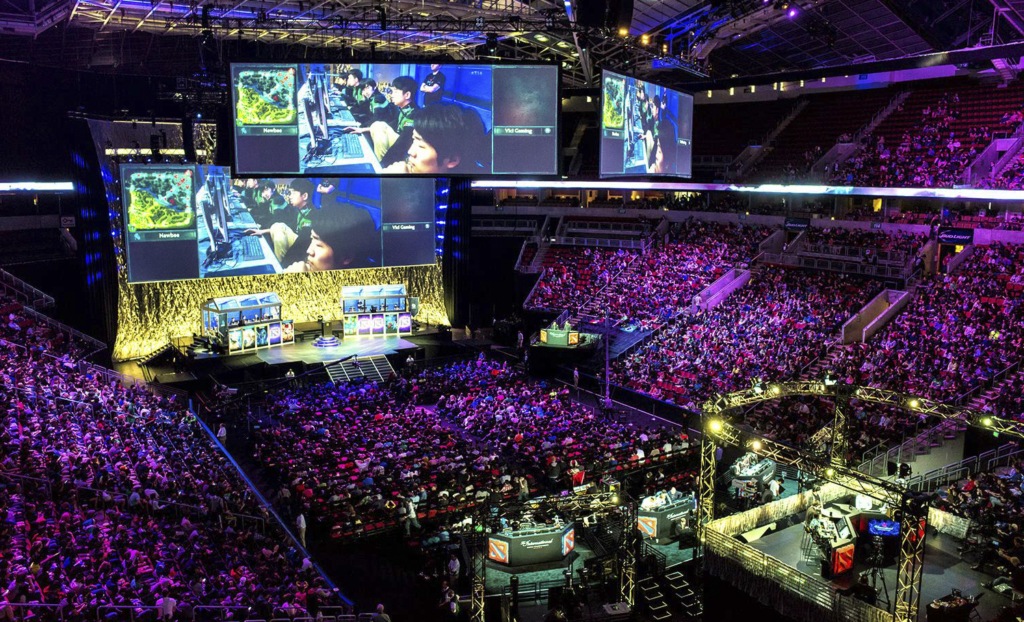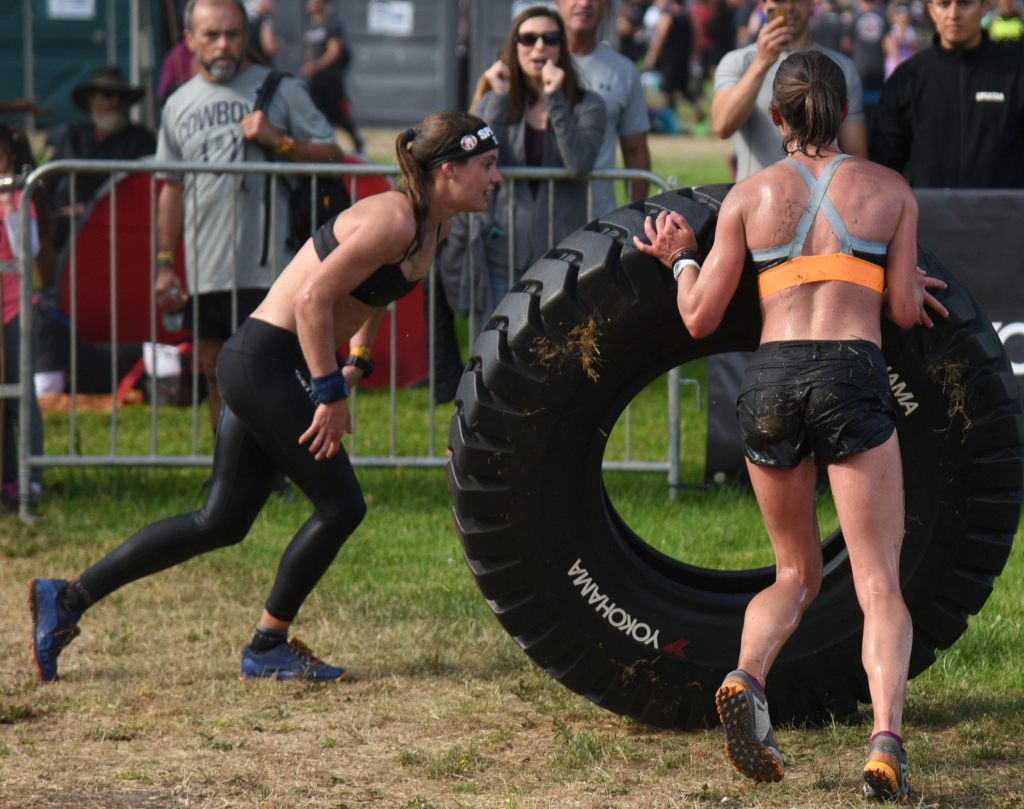
2014 DOTA 2 International Competition
If you are the parent of a teenager who would rather play video games than join you on an obstacle course, you are not alone. My middle son is a DOTA 2 fanatic. For those uninitiated DOTA 2 is a free-to-play multiplayer online battle arena video game developed and published by Valve Corporation. Turns out, there are thousands like him. Truly fanatic. So much so that for eleven straight days, 15,000 of these kids from all over the world will fill the Key Arena in Seattle just to watch a few other kids play each other in video games. The total prize purse is over $20 million dollars this year, the seventh year of the International series.
I know all this because over the weekend, while I could have been watching the CrossFit games, my son was watching DOTA 2 live on TV. I managed to sneak in a few minutes of CrossFit in between rounds. Otherwise, I watched events like Double Under Snatch using Facebook live stream. Upwards of 30,000 people tuned in just to watch people jump rope really fast and lift a barbell over their heads as many times as possible. And that’s when it hit me.

Nobody wants to watch OCR on TV. Even on Facebook Livestream at the Spartan Race US Championship race in Asheville two weeks ago, the highest online viewership was maybe 8,000 to watch a one-hour-ish race. That’s maybe half of the number of screaming teenagers packed into an arena all day long for nearly two weeks just to watch some other lucky kids play video games. That’s maybe twenty-five percent of those who tuned into CrossFit just to watch some very strong athletes try not to herniate their spine discs.
Come on folks.
We claim we are the fastest growing sport in the world. But nobody off of the course seems to care. So how is it that people will pay thousands of dollars every April to stand in the blazing sun of Augusta National to watch guys hit a little white ball up the groomed fairways lined with azaleas? How is it they’ll line the mountain slopes in freezing temperatures just to catch a brief glimpse of skiers zip by at ninety miles an hour? What are we missing?
I talked to my buddy John about this problem yesterday. He’s a sports nut. He has a solution. Just follow the formula. People will pack bleachers for a few reasons. They want to be entertained. For NASCAR, that means they want to see a crash. They want to see drivers risk their lives. They want to see celebrities. They want to live vicariously through them and imagine themselves doing what they do, earning the big bucks like they do. What kid doesn’t want to pocket $20 mil just for playing a game?

(Photo by C Flanigan/Getty Images for Spartan)
Facebook and Spartan.com Livestream are starting to get it. They’ve got three very good announcers in the booth and a few on the course. They know their stuff. They are pros. Brakken Kraker, Amelia Boone, and David Magida are excellent athletes, knowledgeable, and fun to watch. They have good banter, chemistry, and color commentary. All good ingredients. What’s lacking is something to talk about.
Nobody wants to watch eight minutes of bucket brigade. There is very little tension in waiting for Hobie to round the corner with Ryan on his heels, a full minute behind. That’s an eternity in TV. So producers know to fill up that gap with something that increases the tension. It brings the vicarious audience into the story. No, it’s not human interest crap like they did on SUTC. Instead, they show you what it’s like to be a newbie on the course. Then they show you an elite alongside them. Viewers get to see the struggle of the newbie and effortless float of the elite. And best of all, they get to see how it is done. Put Mud Run Guide’s Training Tuesday with Hunter McIntyre and Cassidy Watton in there. Then the viewers say to themselves, “I can do that.”
The missing ingredients are tension and the offer of possibility.
You want to get those gamers off their asses and onto the course?
Offer them that same rush of “That could be me”, the same possibility of pocketing some serious cash, the same opportunity to race the same course as their idols.
The only reason I watched even a moment of the CrossFit Games was to see the obstacle course portion. Hubie Cushman of Indian Mud Run had the honor to help design and build it so it seemed worthwhile to tune in. Nevertheless, the Livestream was interesting for maybe one or two athletes at best. Then it was ho-hum. From an OCR perspective, it was an easy course. Challenging to a CrossFitter? I won’t get into that debate. I’m still not sure what makes for a fanatic base of people tune into that weekend of games.
There’s been very little interest in the U. S. for watching weightlifting since the early 70’s when Soviet heavyweight Vasily Alekseyev set multiple world records in the Olympics. Back then, we had a cold war going on. We wanted to see him fail. We wanted to see the United States dominate. We wanted our man to be the star. But we just couldn’t help watching this giant Russian do his thing. We all had a vested interest in watching two superpowers battle it out with iron instead of nukes. The tension and the story behind the sport was a huge draw for decades. No more.
That is what is missing in broadcast OCR. Tension. It is the essential ingredient known by everybody in the media business. It is script writing 101.
Disclaimer: The viewpoints expressed by the authors do not necessarily reflect the opinions, viewpoints and official policies of Mud Run Guide LLC, or their staff. The comments posted on this Website are solely the opinions of the posters.


Good job articulating the question on a lot of our minds. However, I don’t know if the solution is so clear.
The success of televised golf (which has its own channel) suggests that the length of competition, audience attention span, and sporadic moments of true tension aren’t necessarily defining factors as to whether a program will be successful or not. Whether it’s a major golf tournament, the Crossfit Games, or your son’s favorite video games televised on fringe cable, I think the appeal for viewership is (1) “Here’s the best of the best doing (2) that thing I do…or have done.”
While we hope television success will translate into increased registration/participation, the reality is that the OCR world needs to better capitalize on those already interested and participating. In other words, how do we transform first-time participants into life-long fanatics? The answer is COMMUNITY. Community is why so many Crossfit folks keep coming back for more and wouldn’t dare miss the televised (or streamed) events. While I love the OCR community, it’s nowhere near as organized or proactive as the Crossfit machine. Perhaps that’s the advantage of the sport/brand being one in the same.
You’re right. On top of maintaining those who have already participated, we need to do a better job of educating those on the couch. I’m surprised how often I speak to someone who doesn’t know what obstacle course racing is. They sure don’t know it by its abbreviation. However, when I mention Spartan or Toughest Mudder, they’re pretty sure they’ve heard of it.
“Is that where you run and climb things in the mud?”
“Yes, something like that.”
Rather than spending so much time and money on manufacturing brand loyalty, it may serve the top players well to pull their resources in some type of major campaign designed to educate the general public on a centralized message: “This is OCR, and this is why it’s right for you!” I’m not 100% sure what that would look like, but I’m convinced some muddy soul out there has the answer. Educate the masses and feed the community; then, televised OCR will evolve from take-it-or-leave-it programming to Must See TV!
(Sorry for the long response.)
Thanks Coley for the long response. I picked up on your community tag. It surprised me because I thought it was an OCR strongpoint. You suggest otherwise. I’d like to know more about the XF community and why you and they think it is so much better. You said organization and proactivity are keys. Care to share some examples?
Maybe Spartan should bring back the gladiators then. What would you rather see at the finish, someone hop over some fire or take a hit to the face?